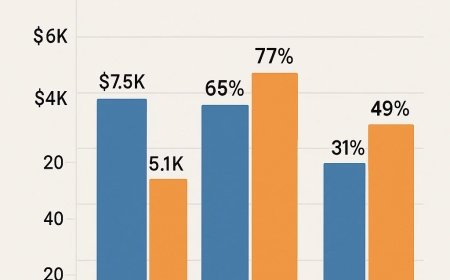Bitcoin Mining Hardware & How High Can Ethereum Go in 2025?
Discover insights into bitcoin mining hardware and explore how high can Ethereum go in 2025 with expert-driven crypto analysis.

The crypto revolution is far from over. Every day, new investors, tech lovers, and passive income seekers explore ways to capitalize on digital assets. Among the most talked-about subjects today are Bitcoin mining and Ethereums price outlook. These two areas, though different in focus, are deeply interconnected in shaping the future of blockchain finance.
This article dives into the world of bitcoin mining hardware while also analyzing Ethereums 2025 potential. Whether you're a beginner or seasoned investor, this guide will help you understand how mining hardware powers Bitcoin and what could drive Ethereums value higher in the coming year.
The Evolution of Bitcoin Mining
Bitcoin mining started with standard computers. Over time, the rise in network difficulty made this method obsolete. As Bitcoin matured, so did the technology used to secure and process its transactions. This led to the rise of bitcoin mining hardware, specialized equipment designed to perform complex calculations with high efficiency.
Back in the early days, CPU and GPU mining were enough. However, with growing competition and increased mining difficulty, ASICs (Application-Specific Integrated Circuits) became the norm. These machines are built solely for one purpose: to mine Bitcoin efficiently, consuming less power and delivering higher hash rates.
WhyBitcoin Mining Hardware Matters Today
Bitcoin mining hardware is now the backbone of the Bitcoin network. It ensures decentralization, maintains blockchain security, and validates transactions. Without modern hardware, Bitcoins performance and reliability would be compromised.
Heres why modern hardware plays such a critical role:
-
Higher efficiency: Newer hardware can process more hashes per second using less energy.
-
Cost-effective operation: Although initial investment may be high, efficient hardware reduces long-term costs.
-
Network strength: More powerful mining hardware boosts the Bitcoin network's overall security.
As mining becomes more competitive, the need for advanced and energy-efficient machines has never been more urgent. Those seeking to earn Bitcoin through mining must consider power consumption, hash rate, and ROI to stay profitable.
Factors to Consider When Choosing Mining Equipment
If you're looking to step into mining, understanding what makes bitcoin mining hardware effective is key. The best setups are those that balance performance with cost.
Here are a few things to evaluate:
-
Hash Rate
The speed at which your hardware can solve a block. A higher hash rate means better chances of earning Bitcoin. -
Energy Efficiency
Power costs can eat into your profits. Efficient hardware that consumes less electricity is crucial. -
Cooling System
Mining rigs produce significant heat. Good ventilation or built-in cooling systems can prevent hardware damage. -
Lifespan and Maintenance
Equipment that lasts longer and requires minimal upkeep is more profitable in the long run. -
Initial Cost vs Return
Dont just go for the most expensive unit. Find the sweet spot between cost and earning potential.
How High Can Ethereum Go in 2025?
How high can Ethereum go is one of the most asked questions in the crypto community. After transitioning to proof-of-stake and reducing its energy footprint, Ethereum has repositioned itself as a sustainable smart contract platform. This could significantly increase its value over the coming year.
Analysts suggest that if Ethereum continues scaling effectively and attracts more developers and dApps, we could see prices move far beyond their previous all-time highs. With the growth of DeFi, NFTs, and Web3 technologies, Ethereum remains at the core of blockchain innovation.
Several factors may influence Ethereums price in 2025:
-
Wider institutional adoption: More businesses are exploring Ethereum for enterprise applications.
-
Layer 2 expansion: Solutions like rollups improve scalability and lower transaction costs.
-
Global regulation clarity: Clearer crypto laws could boost investor confidence.
-
Limited supply pressure: With staking and burning mechanisms, ETH is becoming more scarce.
Some projections even place Ethereum near the five-figure mark if market momentum aligns. While this remains speculative, the fundamentals point to solid growth potential.
The Profitability of Mining vs Staking
Mining Bitcoin and staking Ethereum both offer passive income routes, but they cater to different users. With bitcoin mining hardware, you need physical infrastructure, electricity, and maintenance. In contrast, Ethereum staking requires only holding ETH in a compatible wallet.
Both methods have pros and cons:
-
Bitcoin mining requires upfront capital, but its truly decentralized and offers full network contribution.
-
Ethereum staking is more accessible and energy-efficient but requires long-term asset holding.
Investors often diversify between mining and staking to manage risk and increase exposure across networks.
Key Trends Driving Crypto Hardware Innovation
Several trends are reshaping the development of bitcoin mining hardware in 2025:
-
Sustainability focus: Eco-friendly mining is gaining traction, with many aiming to use renewable energy sources.
-
Compact designs: Smaller, more efficient machines are making mining feasible in smaller environments.
-
Modular upgrades: Hardware that allows part upgrades instead of full replacements is saving miners money.
-
Noise reduction: Quiet operations make home mining a possibility again.
In regions with cheap electricity, mining continues to be a solid income generator. However, miners must remain agile, upgrading rigs as needed to stay profitable.
Security and Decentralization Still Matter
Bitcoin remains the most secure and decentralized crypto asset. And bitcoin mining hardware contributes directly to this strength. Each machine reinforces the blockchain by validating transactions independently. This keeps Bitcoin free from single points of failure.
As the network grows, the importance of individual miners and their equipment only increases. Whether you're running a solo rig or participating in a pool, your hardware plays a role in supporting global financial freedom.
Final Thoughts: Mining Now and Ethereums Future
Crypto continues to evolve rapidly. The tools and strategies that worked yesterday might be outdated tomorrow. But one thing remains clear: having the right bitcoin mining hardware is critical for those looking to benefit from Bitcoins proof-of-work model.
And how high can Ethereum go in 2025 is no longer a far-fetched curiosityits a possibility backed by strong fundamentals and growing adoption. Ethereum is reinventing the internet infrastructure, and that alone suggests its price may rise significantly if trends continue.
Conclusion
Weve explored how bitcoin mining hardware plays a foundational role in maintaining the strength and decentralization of the Bitcoin network. From performance and cost-efficiency to evolving trends and profitability, understanding mining hardware is crucial for anyone entering the space.
On the other hand, Ethereum's future is promising. By examining how high can Ethereum go, we see that its technological roadmap and utility could potentially drive its price to impressive levels by 2025.
Whether you're building a mining farm or simply holding ETH, staying informed and adaptive is the key to succeeding in the world of cryptocurrency.








&srotate=0)

























